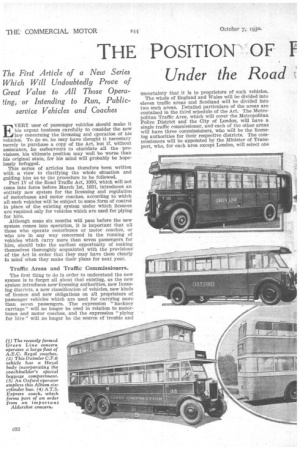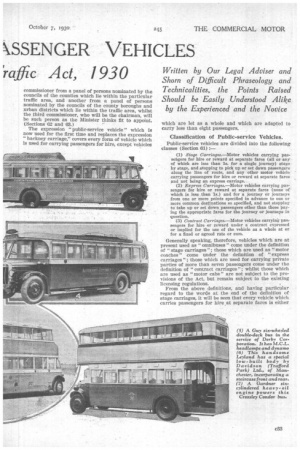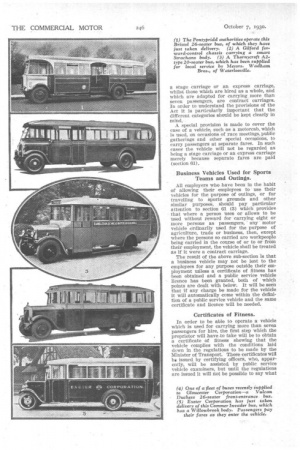THE POSITION OF r kSSENGER VEHICLES
Page 54

Page 55

Page 56

Page 57

If you've noticed an error in this article please click here to report it so we can fix it.
Under the Road
raffic Act, 1930
The First Article of a New Series Which Will Undoubtedly Prove of Great Value to All Those Operating, or Intending to Run, Public service Vehicles and Coaches Written by Our Legal Adviser and Shorn of Difficult Phraseology and Technicalities, the Points Raised Should be Easily Understood Alike by the Experienced and the Novice
EVERY user of passenger vehicles should make it his urgent business carefully to consider the new law concerning the licensing and cperation of his vehicles. To do so, he may have thought it necessary merely to purchase a copy of the Act, but if, without assistance, he endeavours to elucidate all the provisions, his ultimate position may well be worse than his original state, for his mind will probably be hopelessly. befogged.
This series of articles has therefore been written with a view to clarifying the whole situation and guiding him as to the procedure to be followed.
Part IV of the Road Traffic Act, 1930, which will not come into force before March 1st, 1931, introduces an entirely new system for the licensing and regulation of motorbuses and motor coaches, according to which all such vehicles will be subject to some form of control in place of the existing system under which licences are required only for vehicles which are used for plying for hire.
Although some six months will pass before the new system comes into operation, it is important that all those who operate motorbuses or motor coaches, or who are in any way concerned in the running of vehicles which carry more than seven passengers for hire, should take the earliest opportunity of making themselves thoroughly acquainted with the provisions of the Act in order that they may have them clearly in mind when they make their plans for next year.
Traffic Areas and Traffic Commissioners.
The first thing to do in order to understand the new system is to forget all a-bout that existing, as the new system introduces new licensing authorities, new licensing districts, a new classification of vehicles, new kinds of licence and new obligations on all proprietors of passenger vehicles which are used for carrying more than seven passengers. The expression "hackney carriage" will no longer be used in relation to motorbuses and motor coaches, and the expression "plying for hire" will no longer be the source of trouble and uncertainty that it is to proprietors of such vehicles.
The whole of England and Wales will be divided into eleven traffic areas and Scotland will be divided into two such areas. Detailed particulars of the areas are contained in the third schedule of the Act. The Metropolitan Traffic Area, which will cover the Metropolitan Police District and the City of London, will have a single traffic commissioner, and -each of the other areas will have three commissioners, who will be the licensing authorities for their respective districts. The commissioners will be appointed by the Minister of Transport, who, for each area except London, will select one
commissioner from a panel of persons nominated by the councils of the counties which lie within the particular traffic area, and another from a panel of persons nominated by the councils of the county boroughs and urban districts which lie within the traffic area, whilst the third commissioner, who will be the chairman, will be such person as the Minister thinks fit to appoint. (Sections 62 and 63.) The expression "public-service vehicle" which is now used for the first time and replaces the expression "hackney carriage," covers every form of vehicle which is used for carrying passengers for hire, except Vehicles
which are let as a whole and which are adapted to carry less than eight passengers.
Classification of Public-service Vehicles.
Public-service vehicles are divided into the following classes (Section 61) :
(1) Stage Carriages.—Motor vehicles carrying passengers for hire or reward at separate fares (all or any of which are less than is. for a single journey) stage by stage, and stopping to pick up or set down passengers along the line of route, and any other motor vehicle carrying passengers for hire or reward at separate fares and not being an express carriage.
(2) Express Carriages.—Motor vehicles carrying passengers for hire or reward at separate fares (none of which is less than is.) and for a journey cir journeys from one or more points specified in advance to one or more common destinations so specified, and not stopping to take up or set down passengers other than those paying the appropriate fares for the journey or journeys in question. • (3) Contract Carriages.—Motor vehicles carrying passengers for hire or reward under a contract expressed or implied for the use of the vehicle as a whole at or for a fixed or agreed rate or sum.
Generally speaking, therefore, vehicles which are at present used as "omnibuses "come under the definition of "stage carriages " ; those which are used as "motor coaches" come under the definition of "express carriages " ; those which are used for carrying private parties of more than seven passengers come under the definition of " contract carriages " ; whilst those which are used as "motor cabs" are not subject to the provisions of the Act, but remain subject to the existing
licensing regulations. •
From the above definitions, and having particular regard to the words at the end of the definition of stage carriages, it will be seen that every vehicle which carries passengers for hire at separate fares is either a stage carriage or an express carriage, whilst those which are hired as a whole, and which are adapted for carrying more than seven passengers, are contract carriages. In order to understand the provisions of the Act it is particularly important that the different categories should be kept clearly in mind.
A special provision is made to cover the case of a vehicle, such as a motorcab, which is used, on occasions of race meetings, public gatherings and other special occasions, to carry passengers at separate fares. In such eases the vehicle will not be regarded as being a stage carriage or an express carriage merely because separate fares are paid (section 61).
Business Vehicles Used for Sports Teams and Outings.
All employers who have been in the habit of allowing their employees to use their vehicles for the purpose of outings, or for travelling to sports grounds and other similar purposes, should pay particular attention to section 61 (3) which provides that where a person uses or allows to be used without reward for carrying eight or more persons as passengers, any• motor vehicle ordinarily used for the purpose of agriculture, trade or business, then, except where the persons so carried are workpeople being carried in the course of or to or from their employment, the vehicle shall be treated as if it were a contract carriage.
'The result of the above sub-section is that a business vehicle may not be lent to the employees for any purpose outside their employment unless a certificate of fitness has been obtained and a public service vehicle licence has been granted, both of which points are dealt with below. It will be seen that if any charge be made for the vehicle it will automatically come within the definition of a public service vehicle and the same certificate and licence will be needed.
Certificates of Fitness.
In order to be able to operate a vehicle which is used for carrying more than seven passengers for hire, the first step which the proprietor will have to take will be to obtain a certificate of fitness showing that the vehicle complies with the conditions laid down in the regulations to be made by the Minister of Transport. These certificates will In issued by certifying officers, who, apparently, will be assisted, by public service vehicle examiners, but until the regulations are issued it will riot be possible to say what will be the respective duties of the officers and of the examiners (section 68).
A certificate of fitness, when once obtained, will remain in force for five years unless it be previously revoked or cancelled, or unless the certifying officer thinks that the certificate should be issued for a shorter period, not being less than one year. Special arrangements will be made for the issue of certificates of fitness in the case of vehicles of the same type so that where a type vehicle has been passed certificates will be issued in respect of other vehicles of the same type without each vehicle having to be examined.
In order to avoid the difficulty which would be experienced if every public-service vehicle had to be examined as soon as the part of the Act which relates to such vehicles comes into force, it has been provided that the need for a certificate of fitness may be waived by the commissioners during the first four years after that part of the Act comes into force, in respect of vehicles for which licences to ply for hire had been granted before the commencement Of the Act.












































































































